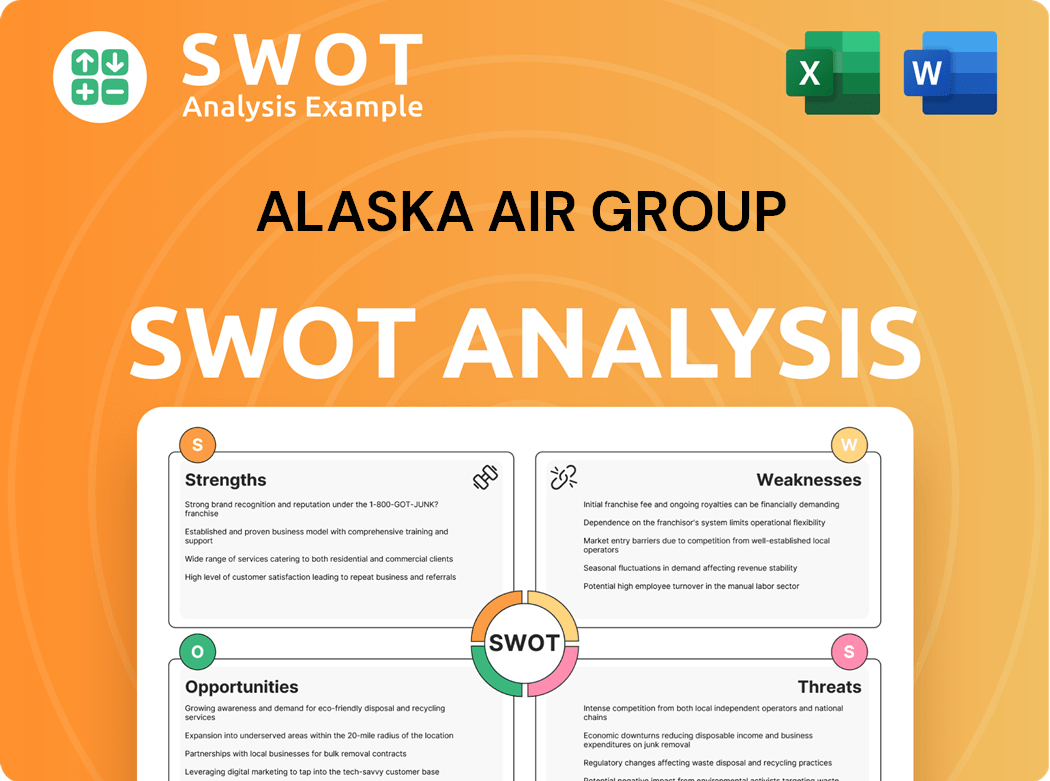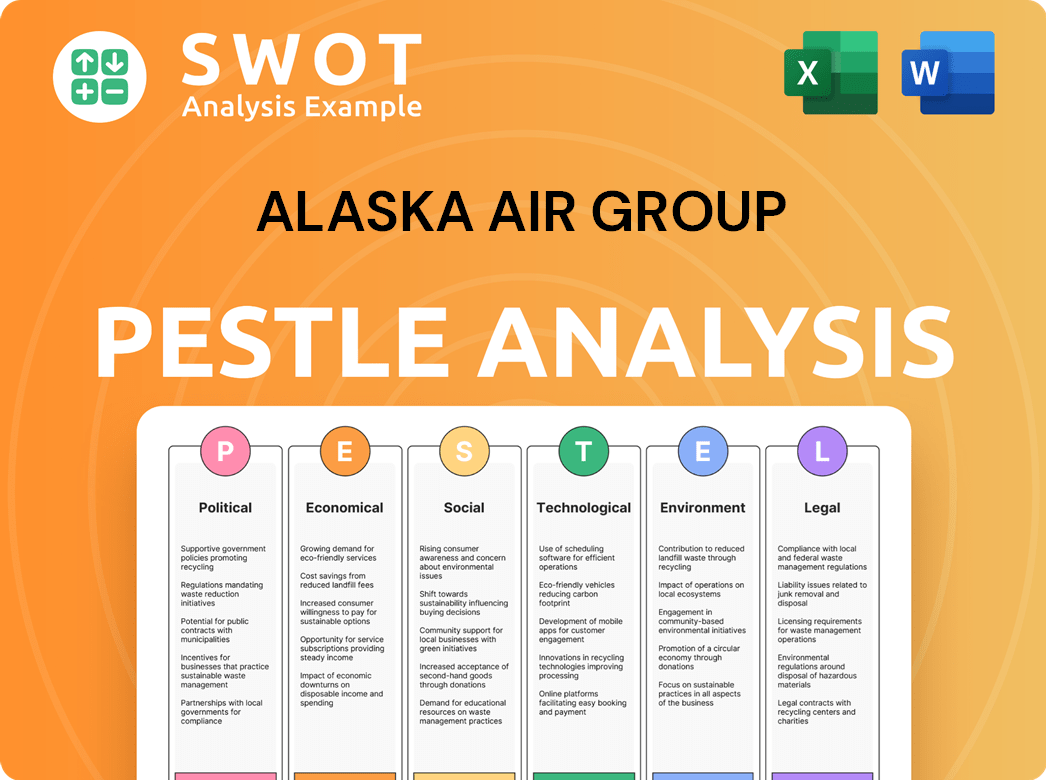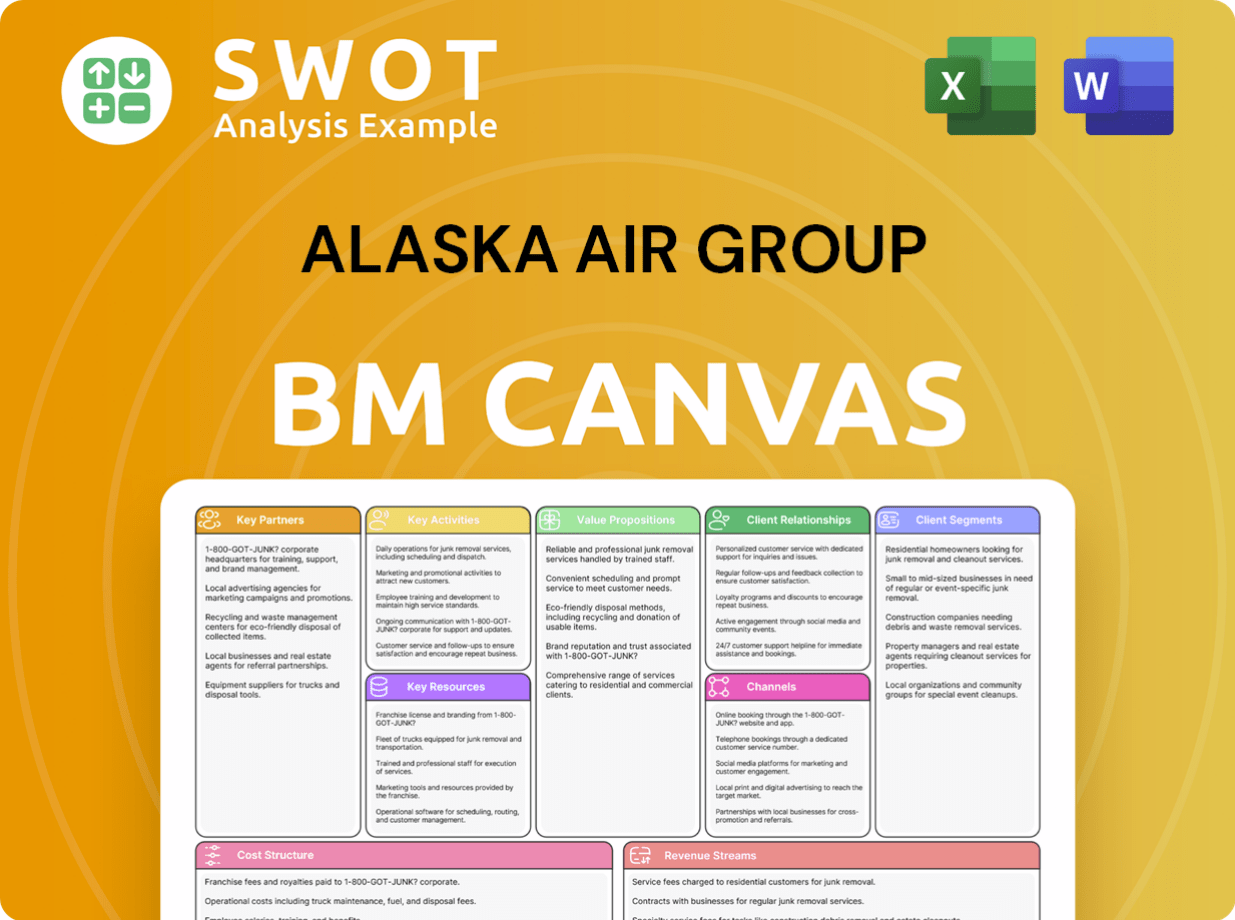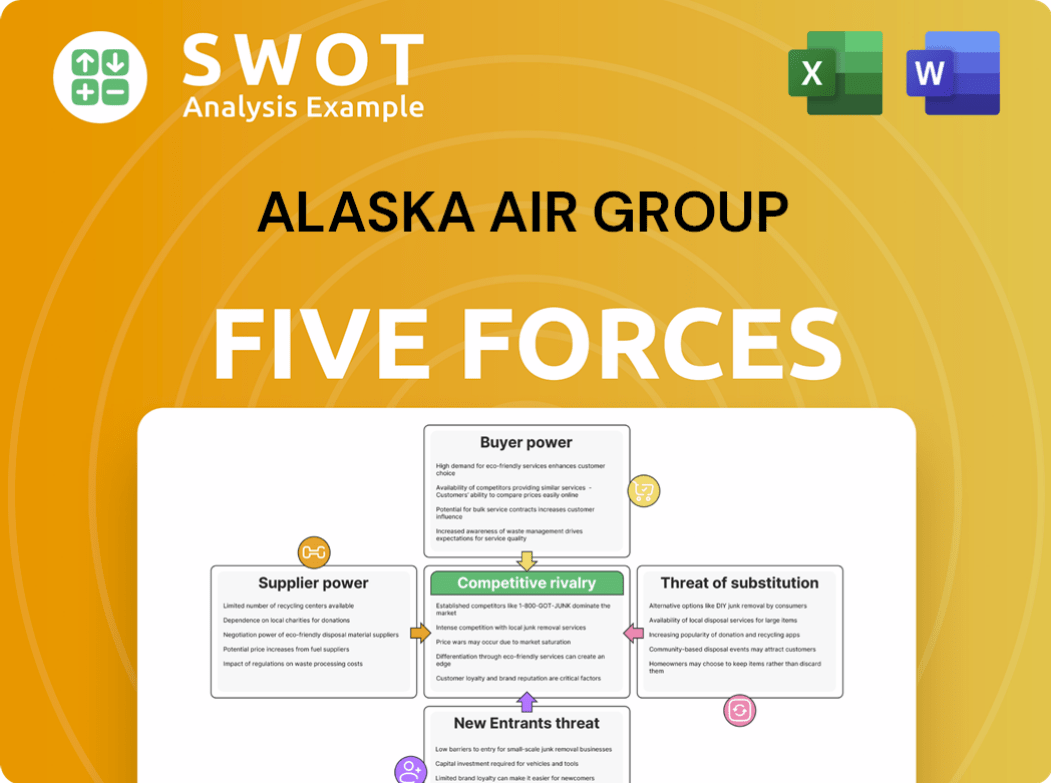Alaska Air Group Bundle
Who Really Controls Alaska Air Group?
Understanding the ownership structure of Alaska Air Group is crucial for investors and industry watchers alike. From its humble beginnings in Alaska to its current status as a major airline group, the company's evolution offers valuable insights. This analysis explores the key players, strategic shifts, and financial performance that shape Alaska Air Group's trajectory.

The Alaska Air Group SWOT Analysis reveals how the company has navigated industry challenges. As a publicly traded entity, understanding the Alaska Airlines ownership and its parent company is vital for anyone considering investing in Alaska Air Group stock. This includes examining the influence of major investors, the roles of Alaska Airlines executives, and the overall corporate governance.
Who Founded Alaska Air Group?
The story of Alaska Air Group, and its flagship carrier, Alaska Airlines, began in 1932. It all started with the vision of Linious Mac McGee, who founded McGee Airways in Anchorage, Alaska. This marked the very beginning of what would evolve into a major player in the aviation industry.
Initially, McGee funded the operations himself, using a single Stinson aircraft to serve remote Alaskan communities. The early days were marked by mergers and name changes. In 1934, McGee Airways joined forces with Star Air Service, creating the largest airline in Alaska at the time.
In 1935, Mac McGee sold his airline's assets to Star Air Service. The company went through several transformations before adopting the name Alaska Airlines in 1944. The formal incorporation of Alaska Airlines took place in 1937 in the state of Alaska. The early ownership structure was primarily driven by the founders and early financial backers, such as Wesley 'Earl' Dunkle.
McGee Airways, founded in 1932 by Linious Mac McGee, marked the start of what would become Alaska Air Group.
The merger with Star Air Service in 1934 created the largest airline in Alaska.
The airline's name evolved from Star Air Service to Alaska Airlines in 1944.
Alaska Airlines was formally incorporated in 1937 in the state of Alaska.
Early ownership was primarily driven by the founders and early backers like Wesley 'Earl' Dunkle.
The founding team's vision was rooted in connecting remote Alaskan communities.
Understanding the early history of Alaska Airlines provides context for its current structure. The initial focus on serving remote communities shaped the airline's culture. For more insights into the company's current strategies, consider exploring the Marketing Strategy of Alaska Air Group.
- Alaska Air Group's origins date back to 1932 with McGee Airways.
- The company went through several mergers and name changes before becoming Alaska Airlines.
- Early funding came from the founders and early backers.
- The initial focus was on connecting remote Alaskan communities.
Alaska Air Group SWOT Analysis
- Complete SWOT Breakdown
- Fully Customizable
- Editable in Excel & Word
- Professional Formatting
- Investor-Ready Format

How Has Alaska Air Group’s Ownership Changed Over Time?
Alaska Air Group, the parent company of Alaska Airlines, was established in 1985 as a holding company. This structure allowed for strategic acquisitions and expansion. A crucial early move was the acquisition of Horizon Air in 1986, followed by Jet America Airlines in the same year, which was merged into Alaska Airlines in 1987. The Airline Deregulation Act of 1978 played a pivotal role, facilitating Alaska Airlines' growth beyond its initial Alaskan focus and into the broader continental U.S. market.
A significant shift occurred in 2016 with the acquisition of Virgin America for approximately $2.6 billion. This strategic move substantially increased Alaska Air Group's presence on the West Coast, adding valuable routes and brand recognition. The legal merger of Virgin America with Alaska Airlines was completed in 2018. In 2024, the acquisition of Hawaiian Holdings, Inc., was announced, with integration efforts underway. This acquisition is projected to generate $1 billion in incremental pretax profit over the next three years. These strategic acquisitions have reshaped the company's strategy, emphasizing network expansion and loyalty program synergies.
| Metric | Value | Date |
|---|---|---|
| Shares Outstanding | 123,078,168 | January 31, 2025 |
| Institutional Ownership | 92.85% | April 2025 |
| Mutual Fund Ownership | 61.96% | April 2025 |
As a publicly traded entity listed on the New York Stock Exchange (NYSE: ALK), Alaska Air Group's ownership is widely distributed. Institutional investors hold a significant portion of the shares. As of April 2025, institutional investors owned 92.85% of the shares. Key institutional shareholders include Vanguard Group Inc, BlackRock, Inc., Fmr Llc, and Dimensional Fund Advisors Lp. For more insights, consider exploring the Competitors Landscape of Alaska Air Group.
Alaska Air Group's ownership is primarily held by institutional investors, with a significant portion also held by mutual funds.
- The company's structure has evolved through strategic acquisitions, including Virgin America and Hawaiian Holdings, Inc.
- The Airline Deregulation Act of 1978 was a catalyst for expansion.
- As of April 2025, insiders held 0.48% of the shares.
- The acquisition of Hawaiian Holdings, Inc., is set to significantly impact the company's financial performance.
Alaska Air Group PESTLE Analysis
- Covers All 6 PESTLE Categories
- No Research Needed – Save Hours of Work
- Built by Experts, Trusted by Consultants
- Instant Download, Ready to Use
- 100% Editable, Fully Customizable

Who Sits on Alaska Air Group’s Board?
The current Board of Directors of Alaska Air Group, Inc. has 10 nominees for election at the 2025 Annual Meeting of Shareholders. All directors serve one-year terms. Independent directors convene at least quarterly without management present. All nominees meet the New York Stock Exchange (NYSE) governance standards for director independence, except for Ben Minicucci, the President and Chief Executive Officer of Alaska Air Group, Inc. and Alaska Airlines, Inc. Patricia M. Bedient chairs the Board.
Understanding the Brief History of Alaska Air Group can provide context to its current structure. The board's composition and structure are critical for the company's corporate governance.
| Director | Title | Key Information |
|---|---|---|
| Ben Minicucci | President and Chief Executive Officer | Not independent due to his executive role. |
| Patricia M. Bedient | Board Chair | Leads the Board. |
| Other Directors | Independent Directors | Meet NYSE governance standards. |
Alaska Air Group operates under a one-share-one-vote structure, with common stock as the sole class of voting shares. As of March 14, 2025, there were 122,751,785 shares of common stock outstanding. Shareholders holding 10 percent or more of the outstanding stock can call a special meeting. Shareholder votes are kept confidential, except in proxy contests or as required by law. Each director is expected to hold shares equivalent to six times their annual cash retainer. In May 2025, the company amended its Certificate of Incorporation to comply with U.S. federal law regarding foreign ownership limitations, introducing ownership restrictions on the company's voting stock.
The voting structure and board composition are key aspects of Alaska Airlines ownership and the Alaska Air Group stock. The Board of Directors oversees the company's strategic direction and ensures that the interests of shareholders are represented.
- One-share-one-vote system.
- Confidentiality of shareholder votes.
- Director share ownership requirements.
- Compliance with foreign ownership regulations.
Alaska Air Group Business Model Canvas
- Complete 9-Block Business Model Canvas
- Effortlessly Communicate Your Business Strategy
- Investor-Ready BMC Format
- 100% Editable and Customizable
- Clear and Structured Layout

What Recent Changes Have Shaped Alaska Air Group’s Ownership Landscape?
Over the past few years, Alaska Air Group has undergone significant changes in its ownership structure. A key development has been the acquisition of Hawaiian Holdings, Inc. in 2024. This strategic move is expected to generate $1 billion in incremental pretax profit within the next three years. The integration efforts, including combining loyalty programs and transitioning to a single passenger service system, are ongoing into 2025 and beyond, influencing the company's operational and financial landscape.
In terms of capital allocation, Alaska Air Group has actively engaged in share buybacks. In 2024, the company repurchased 5.5 million shares of common stock for approximately $312 million. Furthermore, a new $1 billion share repurchase plan was authorized, scheduled to be executed over the next four years, with repurchases starting in January 2025. During the first quarter of 2025, the company repurchased 1.8 million shares of common stock for about $107 million, bringing year-to-date repurchases to $149 million as of April 22, 2025. These actions signal the company's commitment to returning value to shareholders and managing its capital effectively.
| Ownership Category | Percentage (April 2025) | Change from March 2025 |
|---|---|---|
| Institutional Investors | 92.85% | No change |
| Mutual Funds | 61.96% | Decreased |
| Insiders | 0.48% | No change |
The ownership landscape of Alaska Air Group reflects an industry trend toward increased institutional ownership. As of April 2025, institutional investors hold a significant 92.85% of the shares. While institutional ownership remained stable from March to April 2025, mutual funds slightly decreased their holdings from 62.65% to 61.96% during the same period. Insider holdings remained at 0.48% in April 2025. The company's proactive approach to labor relations, with a new agreement for flight attendants approved in March 2025, could potentially boost employee morale and productivity. Public statements also indicate a focus on the successful integration of Hawaiian Airlines and an expected capacity growth of 2% to 3% for 2025.
Institutional investors hold a significant majority of shares, indicating strong confidence from major financial entities. Institutional ownership stands at 92.85% as of April 2025, showing a stable investment trend.
Alaska Air Group actively repurchases its stock to enhance shareholder value. In 2024, $312 million was spent on buybacks, and a new $1 billion plan started in January 2025. The company repurchased $149 million in shares as of April 22, 2025.
The acquisition of Hawaiian Holdings, Inc. is a key strategic move. The integration of the two airlines is ongoing, with expected pretax profit gains of $1 billion over the next three years. This includes combining loyalty programs.
A new agreement for flight attendants was approved in March 2025, potentially boosting employee morale. The company anticipates a capacity growth of 2% to 3% for 2025, showing a focus on expansion.
Alaska Air Group Porter's Five Forces Analysis
- Covers All 5 Competitive Forces in Detail
- Structured for Consultants, Students, and Founders
- 100% Editable in Microsoft Word & Excel
- Instant Digital Download – Use Immediately
- Compatible with Mac & PC – Fully Unlocked

Related Blogs
- What are Mission Vision & Core Values of Alaska Air Group Company?
- What is Competitive Landscape of Alaska Air Group Company?
- What is Growth Strategy and Future Prospects of Alaska Air Group Company?
- How Does Alaska Air Group Company Work?
- What is Sales and Marketing Strategy of Alaska Air Group Company?
- What is Brief History of Alaska Air Group Company?
- What is Customer Demographics and Target Market of Alaska Air Group Company?
Disclaimer
All information, articles, and product details provided on this website are for general informational and educational purposes only. We do not claim any ownership over, nor do we intend to infringe upon, any trademarks, copyrights, logos, brand names, or other intellectual property mentioned or depicted on this site. Such intellectual property remains the property of its respective owners, and any references here are made solely for identification or informational purposes, without implying any affiliation, endorsement, or partnership.
We make no representations or warranties, express or implied, regarding the accuracy, completeness, or suitability of any content or products presented. Nothing on this website should be construed as legal, tax, investment, financial, medical, or other professional advice. In addition, no part of this site—including articles or product references—constitutes a solicitation, recommendation, endorsement, advertisement, or offer to buy or sell any securities, franchises, or other financial instruments, particularly in jurisdictions where such activity would be unlawful.
All content is of a general nature and may not address the specific circumstances of any individual or entity. It is not a substitute for professional advice or services. Any actions you take based on the information provided here are strictly at your own risk. You accept full responsibility for any decisions or outcomes arising from your use of this website and agree to release us from any liability in connection with your use of, or reliance upon, the content or products found herein.